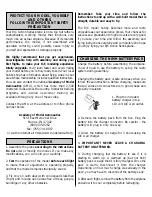
It’s best to fly on calm days, when there’s little or no
wind. Also, find an area clear of trees, power lines and
other structures. A flying field for R/C planes is best.
Don’t fly around groups of people, especially children,
or within 6 miles of existing R/C flying fields.
1. Find an open area free of buildings, trees, power
lines and people.
2. For your first few flights, fly only in winds of no
more than 5 miles per hour. After you are
comfortable with the airplane, you can fly in winds
that are no more than 10 miles per hour. If flown in
stronger winds, the plane may be blown down wind
and not have enough power to get back to you.
3. Make sure the motor battery is fully charged and
that the transmitter has good “AA” batteries installed.
4. If others are flying in the same area, make sure that
they are not using the same channel radio system you
are. The back of your transmitter has a tag with a
number on it (for example CH. 16 72.110). This is the
channel frequency you are using.
5. Range check your radio before each flight. Switch
on the transmitter and then the receiver. Do not push
the motor start button during the first part of the radio
range check. With the antenna collapsed, walk 50
feet away from the airplane. Move the rudder and
elevator control stick, checking that the rudder and
elevator move. Now, have a helper hold the airplane,
press the start button and start the motor. Again,
perform the range test with the motor running. If you
still have control over the airplane, it is safe to extend
the antenna and fly the airplane.
If you have never flown an R/C airplane before, we
recommend that you get help from an experienced
R/C pilot. Most R/C clubs have training programs that
will help you learn to fly quickly. If you cannot find
an experienced pilot to help you learn, the following
will help you get your airplane into the air.
1. First, turn your transmitter power switch “ON.”
This immediately puts you in control. Be sure your
throttle lever on the back of the transmitter is all the
way to the left.
2. Now pick up the airplane and switch the airplane on.
3. Press the start button. Caution: Keep your hands
behind the propeller.
4. Move the throttle lever to the right. The propeller
will start to turn. The farther you move the stick, the
faster the propeller will turn.
5. With the throttle lever moved fully to the right,
hand launch the Aero Cruiser into the wind, at a
slight upward angle. Note: For the first couple of
flights, we recommend having a helper hand launch
the airplane. After you become familiar with the
flight characteristic of the airplane, it can be flown off
a hard surface instead of hand launched.
6. Allow the airplane to climb a few seconds before
turning it.
7. When your plane is moving away from you, moving
the rudder stick to the left will make your plane turn to
the left. Moving the rudder stick to the right will make
the plane turn to the right. By adding a little up elevator
(moving the stick towards you) during the turn, the plane
will turn much tighter. Caution: It only requires a small
amount of up elevator.
8. When the plane is coming toward you, moving the
rudder stick left still causes left rudder, but your plane
goes to your right. In short, you have to reverse the
way you control the rudder. Here's a good way to
familiarize yourself with the controls: When the
plane is coming toward you, turn your body so that
FLYING THE AERO CRUISER
PREPARE FOR TAKEOFF
CHOOSE A GOOD FLYING SITE
10






























